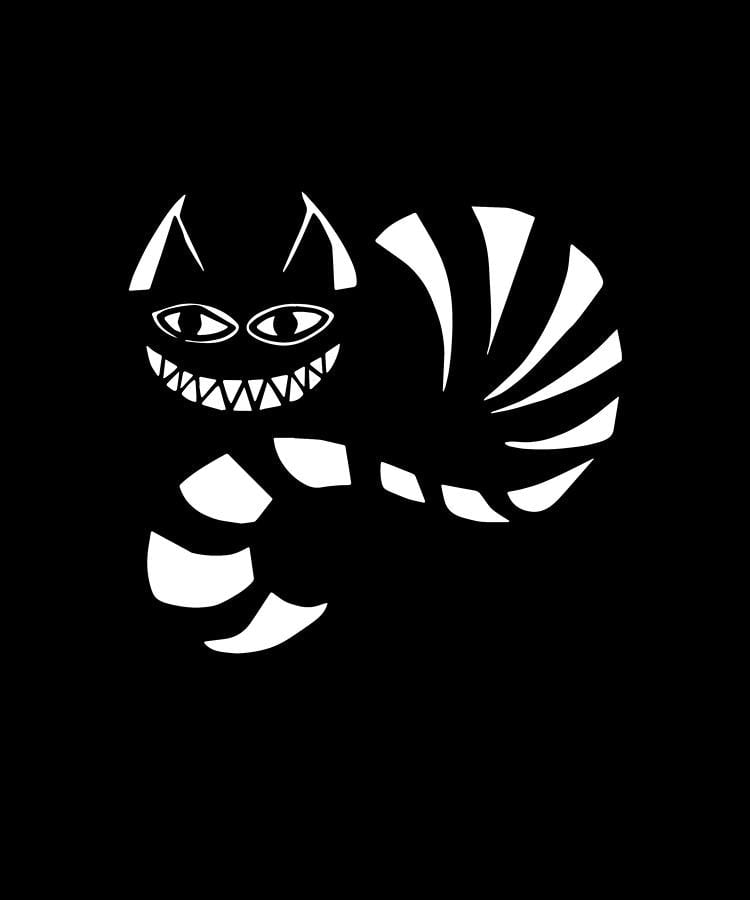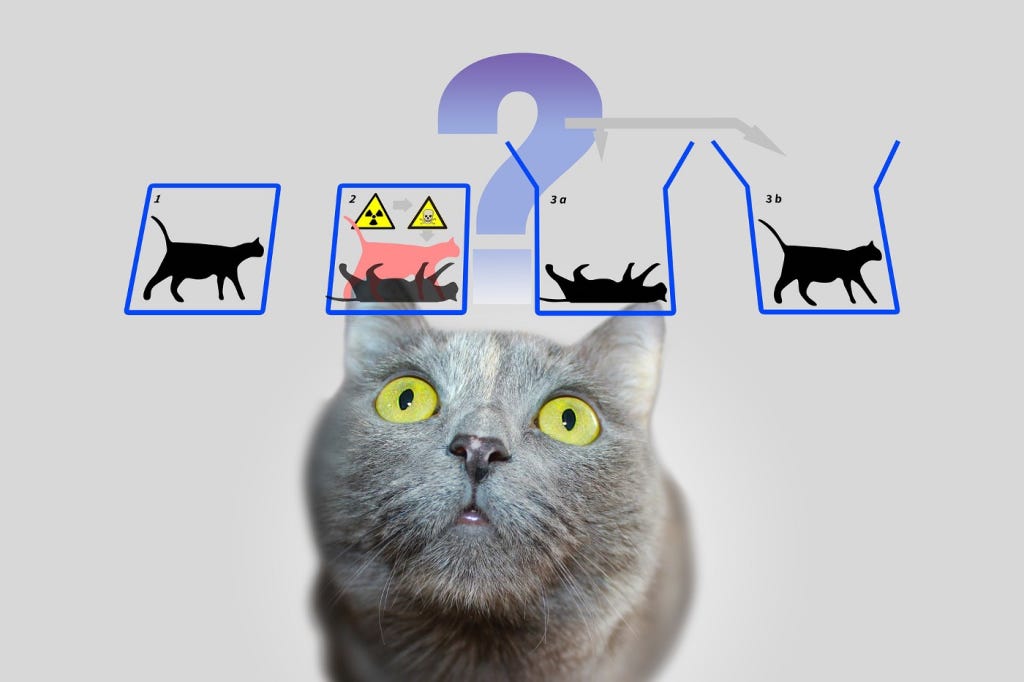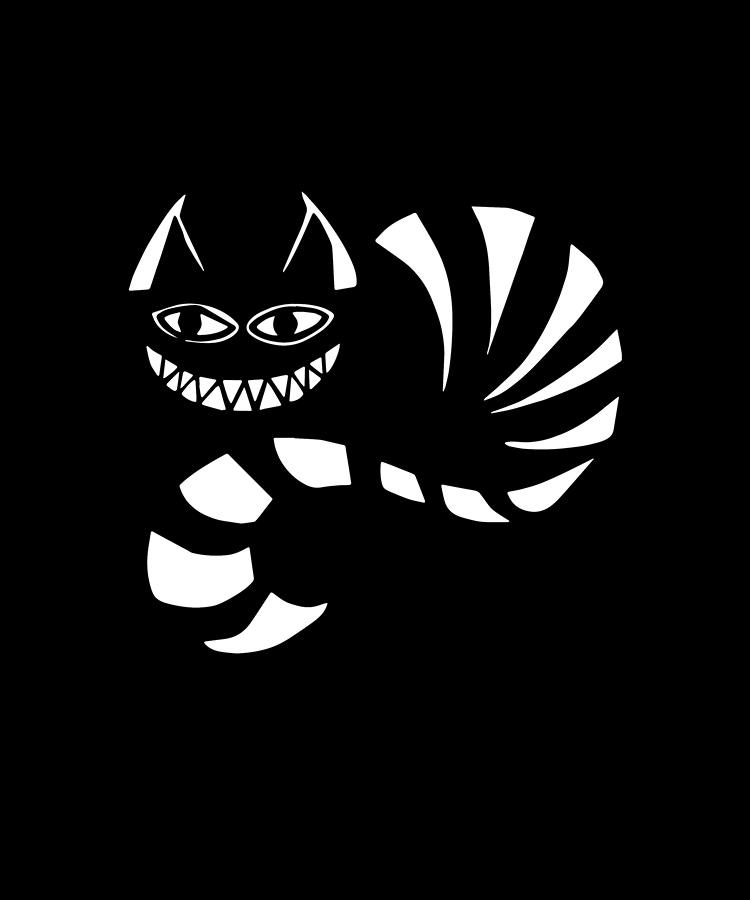Irwin Schrödinger described his Cat Paradox in 1935. You’ve heard the gist described in many ways. In quantum mechanics, if something is possible and something else is possible, it is always possible for the something and something else to exist in superposition. An object can be in two places at once. A proton can be spinning clockwise and counterclockwise at the same time. An electron can be spread out all over the space around the atomic nucleus, and a neurotransmitter molecule can be flipped in open and closed configurations.
So Schrödinger described to us a situation in which the Quantum Cat is alive and dead at the same time. Intuitively, we know that this made no sense. It has to be wrong. That was Schrödinger’s point.
Resolution of the paradox is simple, but it entails a change in world-view that most (not all) physicists have resisted mightily. The change is from reductionist-physicalism to Cartesian dualism. In other words, physicists want to believe that physical reality is the only reality. Particles and fields, energy, space and time are real, and they constitute a closed causal system, influenced by nothing outside them. Talking about spirit or consciousness or God is a distraction that philosophers might indulge, but physics has no need of these ideas, because the physical world is completely explained in terms of physical variables.
By contrast, dualism asserts that there is a physical world and there is a mental world. Both exist in their own terms, and no description of reality can be complete that neglects one to speak exclusively of the other. There are interactions between mind and matter, without which we cannot understand our world.
In the classical physics of the 19th century, the past completely determined the future. It was plausible to argue that there is no room for consciousness to enter in. But in quantum mechanics, the past determines the future only on average. There is an element of “randomness” that enters in. What if the random is not really random? What if Cartesian mind intrudes from its separate realm to bias or even control what traditional quantum physics regards as random? Robert Jahn and Brenda Dunne demonstrated with a 30-year running expermient that the purely mental world can influence physical reality. Their result has been verified more recently with a different experiment setup in the lab of Dean Radin (technical article, video).
Why quantum mechanics needs a separate world of mind
Schrödinger’s formulation of quantum mechanics was based on a wave function as the primary reality. The dynamics of the world is explained as a change in the wave function, and Schrödinger’s equation describes how the wave function changes from moment to moment. Schrödinger’s equation and his wave function were appreciated and accepted for many months before physicists asked the question, How does the wave function relate to anything that can be measured in the laboratory? It was Max Born who proposed the answer that is still accepted today. He said that the wave function can be evaluated at a particular point, or for a particular configuration, and the square of the wave function then tells you the probability of observing that position or that configuration. Where the wave function is large, the probability of finding the particle is high. “Finding the particle” is a measurement, and the word means what you think it means, but it also has a special significance in quantum theory.
As long as a system is not being measured, it continues to hum along in a way described by Schrödinger’s equation. But at the moment a measurement is made, the wave function “collapses”. Schrödinger’s equation ceases to be applicable, and instead the system’s new wave function is described with all the probability stacked up in one place—after all, you can no longer speak of probabilities when you know 100% what was the result of the measurement.
But what’s so special about a measurement? How can we tell definitively when the world is governed by Schrödinger’s equation and when it abruptly changes its state? Whatever the measuring apparatus is, isn’t it made of physical matter? So it has its own Schrödinger equation and its own probability function. If we think in this way, the system and the measuring apparatus can be regarded as one system, and that system has its own big wave function. That big wave function never collapses, because “measurement” is just something within the wave function of the larger system.
Physicists have found many ways to weasel out of this paradox, most involving “decoherence”. It’s clear to me (my personal view, shared by a minority of physicists) that the collapse of the wave function must involve something that’s outside of physics, something that can’t be described by a wave function. My view is that that “something” is naturally identified with mind, or consciousness, or awareness. A “measurement” involves a conscious being learning something new. Collapse of the wave function is essentially an interaction between mind and matter.
Resolution of Schrödinger’s cat paradox
Return now to the cat who is in a superposition of being alive and dead. The reason this makes no sense is that someone knows whether the cat is alive or dead. It is the cat who knows. The cat is continually “measuring” itself to determine that its soul is connected to its body.
“The cat is continually measuring itself to determine that its soul is connected to its body.”
This hints at a definition of life, and a hypothesis about why living things are essentially different from inanimate matter. Living things have an awareness inside them. The awareness is constantly adjusting and juggling quantum probabilities to keep the body alive. Yes, the process of “measuring” can affect the system in directed ways; this is the Inverse Quantum Zeno Effect, but it’s a topic for another day. (Johnjoe McFadden wrote a truly original book on the subject more than 20 years ago.)
The take-home message is that life is a relationship between consciousness and matter. Consciousness takes up residence within a system and biases the probabilities from moment to moment by “measuring” them. This is a hypothesis, the germ of a theory about why life is a special state of matter.
Something special about the living body is that it is put together in a way that magnifies the butterfly effect. In other words, living systems are full of leverage points where a tiny quantum change can affect the behavior of the system as a whole. For example, a single neuron can fire, transmitting an idea that the brain picks up and which carries the brain and its body in some new direction. Human-designed machines are engineered in such a way that quantum fluctuations cannot affect their performance. It is a striking characteristic of the human brain (according to Stuart Kauffman and Dean Radin) that many neurotransmitters are poised on a knife-edge, such that quantum fluctuations can flip them to an active or passive conformation. This is evidence that the brain is a quantum computer, and the mind is its operator.
Imagine a newborn child as a mind connected to an unfamiliar operating system. Her intention makes stomach juices flow, or it makes her arm extend or it makes her eyes close. She gets feedback from the choices she makes as a quantum observer, and gradually learns to direct her brain’s activity and control her muscles.
Schrödinger, late in life, wrote two books speculating about how life works. Francis Crick, late in life, also wrote a book on the relationship between consciousness and living matter. Here’s another book by my new friend, Amy Lansky.




I commend the logic and literary prose of this article, written at a level for all, understandable at a non-scientific level such that it helps to elucidate a complex theme. Well Done. Thank you.
Did the universe spring from superposition to fully formed with an age of billions of years because a mind apprehended within it?
As I see it, a cat, alive, can know and self-measure. A dead cat lacks a mind to know it is dead. It cannot self-measure. The problem of superposition is not a difficulty for the universe, it is only a difficulty for human models of the universe. The universe can do without knowing it does something. Human existence, and human thought arises through a material process that does not know anything, but still it is learning by trial and error with each new generation.
Thanks for your insights. We’re all trying to come toward models that agree with experiment and have a ring of truth.
How mind and consciousness affect matter is a very fascinating subject. I have been researching that myself alot lately. Have viewed alot of Youtube videos on this subject and researhed countless articles on this as well. Fascinating how we can change our personal realities via thought consciousness is especially fascinating. It works. Been experimenting with that myself lately. Anyone can do it with the right formula and daily practice.
How mind and consciousness affect matter is a very fascinating subject. Personally researching this subject alot lately and putting it into practice. One just needs the right formula and to daily put it into practice to see the results one wants to see.
The first time I fully understood the Schrodinger’s Cat paradox. The finest explanation I’ve read.
Thank you